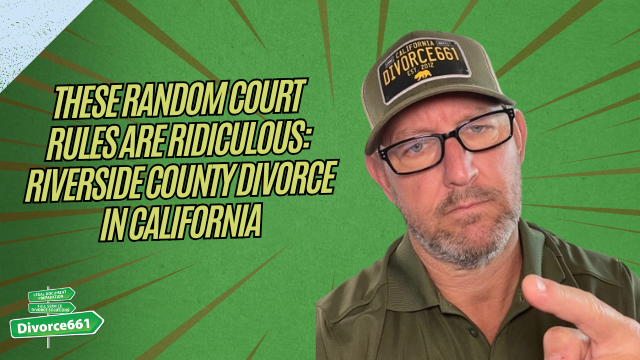🙄 These Random Court Rules Are Ridiculous: Riverside County Divorce in California
When navigating the complexities of divorce in California, understanding court procedures is crucial. However, some local court rules can feel downright frustrating and even counterintuitive. I’m Tim Blankenship from Divorce661, and today I want to shed light on one particularly baffling rule unique to Riverside County that I’ve encountered firsthand.
The Challenge with Filing Amended Summons and Petitions in Riverside County
In most California courts, if you make a mistake on your summons and petition during a divorce case, you can simply file an amended summons and petition without needing prior court approval—even if a default has already been entered. This flexibility allows for corrections to be made quickly and efficiently, helping cases move forward without unnecessary delays.
However, Riverside County takes a very different approach. Here, if you want to file an amended summons and petition—even after defaults have been entered—you cannot do so without first obtaining court permission. This means you must file a stipulation and get the court’s approval before you can proceed. It’s an extra step that other counties don’t require, and it often feels like an unnecessary hurdle.
Why This Rule Feels Ridiculous
From my experience, having to jump through additional hoops just to correct a mistake slows down the process and adds frustration for everyone involved. The purpose of allowing amendments is to fix errors and keep cases on track, not to create roadblocks. Requiring court approval for amendments after a default is not only uncommon across California but also counterproductive.
Imagine you discover a minor error on your petition—something that could be easily fixed with an amended document. In Riverside, you now have to draft a stipulation, submit it for court approval, and wait for a response before you can file the corrected papers. This delay can impact timelines, increase legal costs, and complicate what should be a straightforward fix.
What This Means for Riverside County Divorce Cases
If you’re going through a divorce in Riverside County, it’s important to be aware of this unique procedural requirement. Here are some tips to keep in mind:
- Plan ahead: Double-check your summons and petition before filing to minimize the need for amendments.
- Prepare for delays: If an amendment is necessary, factor in extra time to obtain court approval.
- Work with your attorney: Experienced legal counsel can help you navigate this stipulation process smoothly.
Looking Beyond Riverside: A Call for Consistency
While every court has its own nuances, consistency across jurisdictions benefits everyone involved in family law matters. The ability to file amended summons and petitions without prior court approval is standard practice in most California counties for good reason—it streamlines the process and reduces unnecessary administrative burdens.
Riverside’s insistence on additional approval steps feels outdated and, frankly, a bit ridiculous. Hopefully, awareness of these quirks will encourage local courts to reconsider and align their procedures with the rest of the state, making the divorce process less cumbersome for families during already challenging times.
Final Thoughts
Divorce is never easy, and navigating court rules shouldn’t add to the stress. If you’re dealing with a Riverside County divorce case, be prepared for some unique procedural requirements, like needing court permission to file amended summons and petitions after defaults.
By understanding these rules upfront, you can better manage expectations and work effectively within the system. And remember, having a knowledgeable attorney by your side can make all the difference in handling these unexpected court hurdles.
For more insights and updates on California divorce law and court procedures, stay tuned and follow Divorce661.


